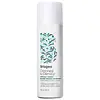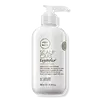What's inside
What's inside
 Key Ingredients
Key Ingredients

 Benefits
Benefits

 Concerns
Concerns

 Ingredients Side-by-side
Ingredients Side-by-side

Water
Skin ConditioningCetyl Alcohol
EmollientStearyl Alcohol
EmollientBrassica Alcohol
EmollientPropanediol
SolventIsopropyl Myristate
EmollientCopper Tripeptide-34
Skin ConditioningCoffea Arabica Seed Oil
MaskingTocopheryl Acetate
AntioxidantPanax Ginseng Root Extract
EmollientCaffeine
Skin ConditioningBiotin
AntiseborrhoeicCetyl Esters
EmollientCamellia Sinensis Leaf Extract
AntimicrobialBrassicyl Isoleucinate Esylate
Emulsion StabilisingCetrimonium Chloride
AntimicrobialGuar Hydroxypropyltrimonium Chloride
Skin ConditioningGlycerin
HumectantLauryl Pyrrolidone
CleansingAloe Barbadensis Leaf Juice
Skin ConditioningUbiquinone
AntioxidantLindera Strychnifolia Root Extract
Skin ConditioningLeuconostoc/Radish Root Ferment Filtrate
AntimicrobialGlycine
BufferingLarix Europaea Wood Extract
HumectantSodium Metabisulfite
AntioxidantZinc Chloride
AntimicrobialCitric Acid
BufferingParfum
MaskingCaprylhydroxamic Acid
Benzyl Alcohol
PerfumingWater, Cetyl Alcohol, Stearyl Alcohol, Brassica Alcohol, Propanediol, Isopropyl Myristate, Copper Tripeptide-34, Coffea Arabica Seed Oil, Tocopheryl Acetate, Panax Ginseng Root Extract, Caffeine, Biotin, Cetyl Esters, Camellia Sinensis Leaf Extract, Brassicyl Isoleucinate Esylate, Cetrimonium Chloride, Guar Hydroxypropyltrimonium Chloride, Glycerin, Lauryl Pyrrolidone, Aloe Barbadensis Leaf Juice, Ubiquinone, Lindera Strychnifolia Root Extract, Leuconostoc/Radish Root Ferment Filtrate, Glycine, Larix Europaea Wood Extract, Sodium Metabisulfite, Zinc Chloride, Citric Acid, Parfum, Caprylhydroxamic Acid, Benzyl Alcohol
Water
Skin ConditioningCetyl Alcohol
EmollientStearyl Alcohol
EmollientCetearyl Alcohol
EmollientOleyl Alcohol
EmollientStearamidopropyl Dimethylamine
EmulsifyingMelaleuca Alternifolia Leaf Oil
AntioxidantTrifolium Pratense Flower Extract
AstringentPyridoxine Hcl
Skin ConditioningRosmarinus Officinalis Leaf Extract
AntimicrobialPanax Ginseng Root Extract
EmollientCurcuma Longa Root Extract
MaskingPisum Sativum Peptide
Skin ConditioningTerminalia Ferdinandiana Fruit Extract
AntioxidantLeuconostoc/Radish Root Ferment Filtrate
AntimicrobialDicetyldimonium Chloride
EmulsifyingGlyceryl Stearate
EmollientAmodimethicone/Morpholinomethyl Silsesquioxane Copolymer
Propylene Glycol
HumectantHydroxyethylcellulose
Emulsion StabilisingTrideceth-5
EmulsifyingDisodium EDTA
Citric Acid
BufferingGlycerin
HumectantMyristyl Alcohol
EmollientMagnesium Nitrate
Cetrimonium Chloride
AntimicrobialPhenoxyethanol
PreservativeMethylchloroisothiazolinone
PreservativeMethylisothiazolinone
PreservativeCI 16035
Cosmetic ColorantCaramel
Cosmetic ColorantParfum
MaskingLinalool
PerfumingGeraniol
PerfumingWater, Cetyl Alcohol, Stearyl Alcohol, Cetearyl Alcohol, Oleyl Alcohol, Stearamidopropyl Dimethylamine, Melaleuca Alternifolia Leaf Oil, Trifolium Pratense Flower Extract, Pyridoxine Hcl, Rosmarinus Officinalis Leaf Extract, Panax Ginseng Root Extract, Curcuma Longa Root Extract, Pisum Sativum Peptide, Terminalia Ferdinandiana Fruit Extract, Leuconostoc/Radish Root Ferment Filtrate, Dicetyldimonium Chloride, Glyceryl Stearate, Amodimethicone/Morpholinomethyl Silsesquioxane Copolymer, Propylene Glycol, Hydroxyethylcellulose, Trideceth-5, Disodium EDTA, Citric Acid, Glycerin, Myristyl Alcohol, Magnesium Nitrate, Cetrimonium Chloride, Phenoxyethanol, Methylchloroisothiazolinone, Methylisothiazolinone, CI 16035, Caramel, Parfum, Linalool, Geraniol
Ingredients Explained
These ingredients are found in both products.
Ingredients higher up in an ingredient list are typically present in a larger amount.
This ingredient is a preservative, antimicrobial, and emulsifier. It is often used in cosmetics for its ability to cleanse, condition, and reduce static.
Cetrimonium chloride is a quaternary ammonium salt, meaning it has a water-soluble structure.
Cetyl Alcohol is a fatty alcohol. Fatty Alcohols are most often used as an emollient or to thicken a product.
Its main roles are:
Though it has "alcohol" in the name, it is not related to denatured alcohol or ethyl alcohol.
The FDA allows products labeled "alcohol-free" to have fatty alcohols.
Learn more about Cetyl AlcoholCitric Acid is an alpha hydroxy acid (AHA) naturally found in citrus fruits like oranges, lemons, and limes.
Like other AHAs, citric acid can exfoliate skin by breaking down the bonds that hold dead skin cells together. This helps reveal smoother and brighter skin underneath.
However, this exfoliating effect only happens at high concentrations (20%) which can be hard to find in cosmetic products.
Due to this, citric acid is usually included in small amounts as a pH adjuster. This helps keep products slightly more acidic and compatible with skin's natural pH.
In skincare formulas, citric acid can:
While it can provide some skin benefits, research shows lactic acid and glycolic acid are generally more effective and less irritating exfoliants.
Most citric acid used in skincare today is made by fermenting sugars (usually from molasses). This synthetic version is identical to the natural citrus form but easier to stabilize and use in formulations.
Read more about some other popular AHA's here:
Learn more about Citric AcidGlycerin is already naturally found in your skin. It helps moisturize and protect your skin.
A study from 2016 found glycerin to be more effective as a humectant than AHAs and hyaluronic acid.
As a humectant, it helps the skin stay hydrated by pulling moisture to your skin. The low molecular weight of glycerin allows it to pull moisture into the deeper layers of your skin.
Hydrated skin improves your skin barrier; Your skin barrier helps protect against irritants and bacteria.
Glycerin has also been found to have antimicrobial and antiviral properties. Due to these properties, glycerin is often used in wound and burn treatments.
In cosmetics, glycerin is usually derived from plants such as soybean or palm. However, it can also be sourced from animals, such as tallow or animal fat.
This ingredient is organic, colorless, odorless, and non-toxic.
Glycerin is the name for this ingredient in American English. British English uses Glycerol/Glycerine.
Learn more about GlycerinLeuconostoc/Radish Root Ferment Filtrate is a natural preservative. It comes from fermenting radish roots with a bacteria called leuconostoc.
Leuconostoc comes from lactic acid.
This ingredient has antimicrobial properties and helps prevent the growth of bacteria in a product.
Leuconostoc is used to make the traditional Korean side-dish, kimchi. It is also used to make sourdough bread (both incredibly yummy foods).
Learn more about Leuconostoc/Radish Root Ferment FiltrateGinseng root is a well-loved ingredient in Asian skincare for good reason. It hydrates the skin, soothes irritation, and helps even out skin tone.
In traditional East Asian medicine, ginseng has been used for centuries both as food and as a healing remedy, and modern research continues to confirm its skin benefits.
One of the standout features of ginseng is its ability to improve blood circulation and oxygen delivery to the skin, bringing a fresh supply of nutrients to support overall skin health. It also has antioxidant and anti-inflammatory properties. This helps to protect your skin against damage from UV exposure, pollution, and daily stress.
Additionally, studies suggest that ginseng may help reduce hyperpigmentation by inhibiting tyrosinase, the enzyme involved in melanin production.
There are different types of ginseng used in skincare, and while they all share core benefits, their potency can vary.
Most products use fresh or white ginseng because it’s more affordable. However, red ginseng, produced by steaming the root, contains higher levels of ginsenosides, which are compounds with proven anti-aging effects. These ginsenosides help reduce the appearance of wrinkles and improve skin elasticity.
Note: All forms of ginseng are listed simply as “Panax ginseng” in ingredient lists. We recommend reaching out to the brand if you have questions about which type of ginseng is used in their ingredients.
For general antioxidant benefits, any ginseng extract will do, but for wrinkle care or firmer skin, red or fermented ginseng is often more effective.
In short, ginseng is a powerhouse ingredient that supports hydration, radiance, and resilience.
Learn more about Panax Ginseng Root ExtractParfum is a catch-all term for an ingredient or more that is used to give a scent to products.
Also called "fragrance", this ingredient can be a blend of hundreds of chemicals or plant oils. This means every product with "fragrance" or "parfum" in the ingredients list is a different mixture.
For instance, Habanolide is a proprietary trade name for a specific aroma chemical. When used as a fragrance ingredient in cosmetics, most aroma chemicals fall under the broad labeling category of “FRAGRANCE” or “PARFUM” according to EU and US regulations.
The term 'parfum' or 'fragrance' is not regulated in many countries. In many cases, it is up to the brand to define this term.
For instance, many brands choose to label themselves as "fragrance-free" because they are not using synthetic fragrances. However, their products may still contain ingredients such as essential oils that are considered a fragrance by INCI standards.
One example is Calendula flower extract. Calendula is an essential oil that still imparts a scent or 'fragrance'.
Depending on the blend, the ingredients in the mixture can cause allergies and sensitivities on the skin. Some ingredients that are known EU allergens include linalool and citronellol.
Parfum can also be used to mask or cover an unpleasant scent.
The bottom line is: not all fragrances/parfum/ingredients are created equally. If you are worried about fragrances, we recommend taking a closer look at an ingredient. And of course, we always recommend speaking with a professional.
Learn more about ParfumStearyl Alcohol is a type of fatty alcohol from stearic acid. It is a white, waxy compound used to emulsify ingredients.
Fatty Alcohols are most often used as an emollient or to thicken a product. Emollients help soothe and hydrate the skin by trapping moisture.
They are usually derived from natural fats and oils and therefore do not have the same drying or irritating effect as solvent alcohols. FDA allows products labeled "alcohol-free" to have fatty alcohols.
Learn more about Stearyl AlcoholWater. It's the most common cosmetic ingredient of all. You'll usually see it at the top of ingredient lists, meaning that it makes up the largest part of the product.
So why is it so popular? Water most often acts as a solvent - this means that it helps dissolve other ingredients into the formulation.
You'll also recognize water as that liquid we all need to stay alive. If you see this, drink a glass of water. Stay hydrated!
Learn more about Water